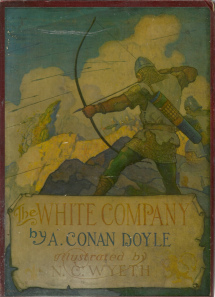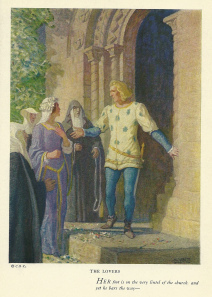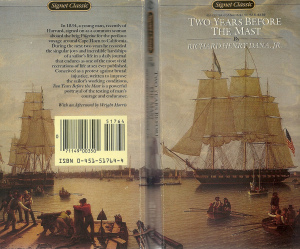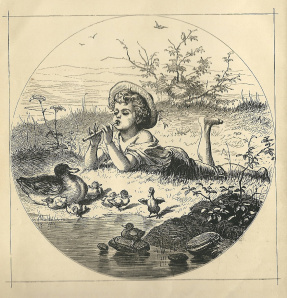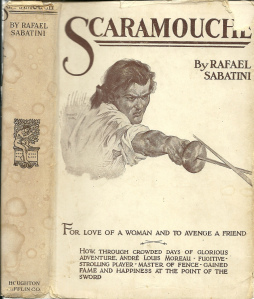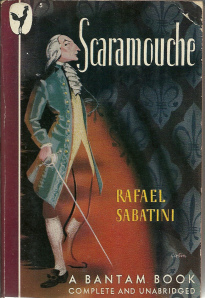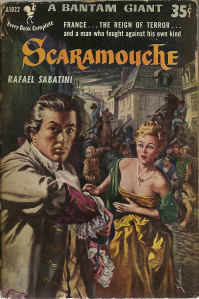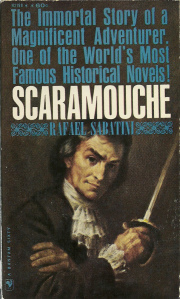Joe L. Wheeler's Blog, page 9
April 30, 2014
Sir Arthur Conan Doyle’s “The White Company
BLOG #18, SERIES #5
WEDNESDAYS WITH DR. JOE
DR. JOE’S BOOK OF THE MONTH CLUB
SIR ARTHUR CONAN DOYLE’S THE WHITE COMPANY
April 30, 2014
For our May selection, I am reaching back to a book I reveled in as a boy, Sir Arthur Conan Doyle’s The White Company (originally published in 1890). Before selecting it as our 29th Book of the Month, somewhat apprehensively, I re-read it to see if it still had the magic and romance it had for me as an adolescent and teenager. Not to worry–it was just as gripping now as it had been back then.
Why was I apprehensive? Because of the recent Sherlock Holmes movies that portray him and his constant sidekick Dr. Watson as violent, sex-addicted, spiritualistic, and into drugs. And that was not how I remembered him in The White Company. Nor was it, generally speaking, in the original Sherlock Holmes stories. True, the spiritualistic and drug elements are in the Sherlock Holmes stories, but they were understated. Indeed, The White Company doesn’t even contain foreshadowing that Doyle would desert the audience that made him wealthy in the first place.
But it is comforting to be reassured that The White Company is all I remembered it to be when I was young. The ultimate books to me are the ones you re-read, each time with enjoyment almost as great as the time you first read them. Here is my February 28, 2014 reaction: What a story! What a prodigious work of research and scholarship it took to bring back the wild, bloody, yet glorious Fourteenth Century, the heyday of the archers and the beginning of the long decline of armored knights. Doyle brings all of them to vibrant life. You feel you are in that century, on the eve of England’s losing France. Young people have always loved the book. More mainstream than later spiritualistic druggy Doyle. A tremendous read!
Arthur Conan Doyle (1859-1930) was born into a prominent Irish Catholic family (son of the artist Charles Doyle). Doyle was educated in Stoneyhurst, in Germany, then returned to earn his medical degree at Edinburgh University. He then practiced as a physician from 1882 – 1890. But after trying his hand at writing historical fiction, he concluded that writing was more remunerative than medicine. Three of his most popular novels turned out to be Micah Clarke (1889), The White Company (1890), and Sir Nigel (1906).
When Britain was drawn into the fiercely fought and bloody Boer War (1899-1902), Doyle volunteered as a senior field physician. In 1902, he was knighted for his wartime contributions. It was while he was in Africa that Doyle wrote his semi-utopia, The Lost World (1912), for which he created a new character, Professor Challenger, who also starred in the sequel, The Poison Belt (2013). Doyle also created a Napoleonic Wars hero, Brigadier Girard.
But it was the creation of the subtle hawk-eyed amateur detective Sherlock Holmes that catapulted Doyle to world-wide fame. His stolid roommate, both friend and foil, Dr. Watson cemented them as a team. The Strand (one of the era’s finest magazines) carried almost all of their crime-solving adventures.
James D. Hart, author of The Popular Book (Berkeley, California: University of California Press, 1963), a reprint of the original book by Oxford University Press in 1950), had this to say about the pair’s international success: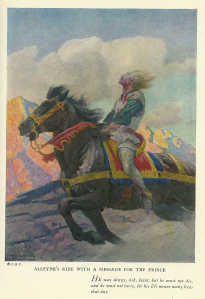
“Doyle arrived in America for a lecture tour in 1894, “four years after A Study in Scarlet, the first of his detective stories, appeared in this country. His popularity grew through three editions of this book, The Sign of the Four, The Adventures of Sherlock Holmes, and The Memoirs of Sherlock Holmes. Doyle had begun as a conventional historical romancer, but later he applied the techniques of the romance to a new type of fiction. The American public came to know him only as the creator of two characters permanently enshrined in this nation’s literary mythology–Sherlock Holmes the master detective and his friend Watson, who could grasp only the most elementary clue… He created simple, clear characters whose personalities remained constant but whose thrilling adventures were ever changing–ingredients typical of the romance, which emphasizes the excitements of plot involving characters clearly representative of good and evil”, (p. 198).
It shouldn’t be difficult for you to pick up an unabridged copy of The White Company, but I urge you to secure, if at all possible, the Cosmopolitan Book Corporation’s 1922 edition, with its magnificent N. C. Wyeth color illustrations. Prepare for a timeless great read, one that all generations will revel in.


April 23, 2014
WE DON’T TAKE SNOW FOR GRANTED
BLOG #17, SERIES #5
WEDNESDAYS WITH DR. JOE
WE DON’T TAKE SNOW FOR GRANTED
April 23, 2014
Much of the Southwest is in drought mode. Even California, the breadbasket of the nation.
Snow and rain. Human life could not live without moisture, consequently millions of people are concerned about climate change. Each year, here in the Colorado Rockies, many worry that this year we won’t have enough moisture for our crops, this year the rivers won’t bring life to counties or states fed by rivers born in the Rockies, this year lack of snow may cut the ski season short, this year our wells may run dry, this year wind and fire may combine to burn up everything we own. The list could go on and on.
But one thing is for sure: we do not take weather for granted. Mankind never has.
In a service club I’m a part of, every week we collect what we call “happy dollars” (which we then donate to our annual literacy campaign). As each of us weighs in on what we are happiest about, almost always weather comes up: if we’ve had a good snowfall or a good rain, invariably at least one member calls attention to it; in the opening invocation, God is usually thanked for whatever moisture comes our way. And when moisture does not come, God is reminded in the invocation that we’d sure appreciate more snow, or more rain.
At the elevation where we live (9,700′), we get lots of snow. In fact, a neighbor and I keep track year by year. Over an eighteen-year period, we have averaged 200-230 inches of snow a year. We’re under normal for this year, but we keep hoping more snow will fall–and if it doesn’t, we’ll hope and pray that God will grant us a long summer monsoon season of rain.
How good God is.


April 16, 2014
QUOTATIONS TO LIVE BY
BLOG #16, SERIES #5
WEDNESDAYS WITH DR. JOE
QUOTATIONS TO LIVE BY
April 16, 2014
It is said that poetry is the most condensed literary art form there is–much more than is true of novels and short stories. I would disagree: quotations are even more condensed than poems.
Of course that gets us into the debate as to whether quotations deserve to be classified as an art form. I submit that they are. It is almost impossible to create shorter condensations of wisdom than in quotations.
For example, how could it be possible to condense the essence of the following any further than these?
“God is Love” (John 4:8)
“I came, I saw, I conquered” (Julilus Caesar)
“All the World’s a Stage.” (Shakespeare)
“What’s past is prologue” (Shakespeare)
“To err is human, to forgive divine.” (Pope)
“Jesus wept” (John 11:35)
Looking back through time, I think I was first captivated by quotations in the old Reader’s Digest. In their early days, their editors routinely featured quotations worth remembering, the essence of Alexander Pope’s immortal “What oft was thought, but ne’er so well expressed.”
All of us aspire to be witty, to articulate thought so splendidly listeners will be in awe of us. But if we are not the first to come up with timeless phraseology–well the artist James McNeill Whistler captured it best in a conversation he had with Oscar Wilde:
Wilde: “I wish I’d said that.”
Whistler: “You will, Oscar, you will.”
Early on in teaching, I wrote on my classroom blackboard one morning, a quotation I felt worth remembering. I wrote another on the board the following day, and so on. It didn’t take long to discover that it was the first thing students noticed when they walked into the room.
Over time, that daily quotation became part of my persona. So much so that if I missed a day, my students demanded I immediately remedy that omission.
Fast forward to the last eighteen years of writing and anthologizing full time. As books bearing my name accumulated, former students began checking back in. A number mentioned those long-ago quotations–many had copied down their favorites: a number still had them. Several suggested I take advantage of the worldwide web and tweet one every day. That way, they could still pretend they were students of mine.
So it was that on October 1 of 2011, I tweeted my first quotation. I have not missed a day since. In late June of 2014, I’ll long in my 1000th quotation.
I take these postings mighty seriously for I want each of them to be worth remembering. I’ve discovered that most quotation books are merely compendiums of quotations, mighty few of them worth writing down, even fewer worth internalizing.
Though I have well over a million quotes archived, it is never easy to select a month’s worth of quotes. For I determined early on to avoid merely posting same ol’ same ol’s; quotes originating with individuals many of our contemporaries don’t even recognize. Because of this, in order to maintain a good mix of quotes old and new, I continuously search for current quotes worth remembering. I add humorous ones as day-brightening changes of pace as well. But always I also feature the greatest ones from ages past.
I’ll be most interested in your reactions to our quotes. If enough interest is expressed, I’ll consider making them available in printed form as well.
If you like quotes but haven’t yet checked ours out, you can access them at http://www.twitter.com/JoeWheelerBooks.


April 9, 2014
JUST ONE DAY AT A TIME
BLOG #15, SERIES #5
WEDNESDAYS WITH DR. JOE
JUST ONE DAY AT A TIME
April 9, 2014
Next to me in an office supply store line was a young woman in her mid to late 30s. She was working so hard to get just right a lamination of a long sheet of quotations that everyone in the waiting line got interested in her. Turns out that it wasn’t even for her, but for a dear friend. When I mentioned to her that her friend was lucky to have such a caring friend, she remarked in a very soft voice to me that creating this gift for her friend took her mind off her own troubles.
Conversationally, almost as an aside, I said, “Hopefully, your troubles aren’t too bad.”
When she puddled up, I realized I was in too deep to back out without further dialogue, and, well, one question led to another and before I knew it we’d moved away from the counter so she could speak confidentially. It helped that she’d purchased some of my books in recent years and trusted me.
It was far far worse than I had imagined: her husband had recently died from cancer. . . . Her teenage son had got in with the wrong crowd, overdosed on drugs, and died. . . . Without her husband’s income, she’d lost their home. . . . And the final straw: she’d lost her job too. She was homeless and destitute and didn’t know where in the world to turn.
She summed it all up with these poignant words: “God is my last resort, and I struggle to make sense of it all one day at a time.”
“One day at a time.”
* * * * *
Which reminds me of another encounter I had in a hospital break room a few years ago. I incorporated it into my story, “The Clock of Life.” in Christmas in My Heart 18 almost five years ago.
I’d been operated on for an obstruction in my bile duct that had resulted in my skin turning yellow with jaundice. My hospitalist had told me that if I made it to dawn without the most excruciating pain I’d ever experienced, that would mean I’d escaped pancreatitis. So I walked the hospital corridors hour after hour, stopping once in a while in the break room. Once, there was a woman sitting there who was the spouse of another patient in the ward. Turned out that her husband had a rare virulent form of leukemia. When I asked how severe it was, she answered almost matter of factly, “He can’t even turn over without my help.”
I followed up by asking, “And how long has he had this condition?”
There was a very long pause before, in a soft but strained voice, she answered, “Twenty-five years!”“
I was so stunned, I was almost unable to speak. Finally, I said, “Twenty-five years?”
She nodded. “Yes. And in all that time I’ve never left him–not even for a day.”
I could only stammer, “My dear woman, how do you do it?”
Never will I forget her response: “God gives me strength for one day at a time.”
* * * * *
I was on the phone for over an hour one night recently. On the other end of the line was a friend I’d worked with in a university some years before. His voice was so soft I hardly recognized it. He’d been diagnosed with pancreatic cancer and was so weak he couldn’t even get out of his chair without his wife’s help. He was undergoing 28-day cycles of radiation, each of which did all but kill him. The prognosis looked anything but good.
In situations like this one is almost incapable of speech. What do you say to a dear one who knows for a certainty that, unless a miracle takes place, he is living his last hours in life?
I told him I’d been praying for him. He told me that many others were praying for him too. . . and added, “It’s not too hard: we all know we’re going to die, so it’s not an “if,” only a “when.” And clearly he was getting his house in order: family and close friends visited him or phoned him often.
And he now lived “one day at a time.”
Before I signed of, he thanked me again for taking the time to call, saying, “You’re part of what means most to me: true friends who stay by me to the end.”
* * * * *
One day at a time. . . . God gives us strength for one day at a time.


April 2, 2014
Does Reading Literature Actually Make Us Smarter?
BLOG #14, SERIES #5
WEDNESDAYS WITH DR. JOE
DOES READING LITERATURE ACTUALLY MAKE US SMARTER?
April 2, 2014
This is anything but a dead issue today with so many millions of people out of work. Even those with advanced degrees. No small thanks to the national fixation on all these jobless individuals desperately searching for good jobs, there have been many writers, pundits, and producers who have openly denigrated the study of humanities and urged young people to choose more “prac tical” courses of study, degreed programs sanctified by high job placement.
So, are the humanities doomed? Obsolete? Irrelevant in our cyber world? Is there anything at all practical about reading literature?
Knowing of my interest in this subject, Dr. Rosanne Vrugtman sent me Annie Murphy Paul’s splendid response to these questions. Her title includes two additional words:
“Does Reading Literature Make Us Smarter and Nicer?”
Let’s see what she has to say on the subject:
“Gregory Currie, a professor of philosophy at the University of Nottingham, recently argued in the New York Times that we ought not to claim that literature improves us as people, because there is no “compelling evidence that suggests that people are morally or socially better for reading Tolstoy” or other great books.
“Actually, there is such evidence. Raymond Mar, a psychologist at York University in Canada, and Keith Oatley, a professor emeritus of cognitive psychology at the University of Toronto, reported in studies published in 2006 and 2009 that individuals who often read fiction appear to be better able to understand other people, empathize with them and view the world from their perspective. This link persisted even after the researchers factored in the possibility that more empathetic individuals might choose to read more novels. A 2010 study by Mar found a similar result in young children: the more stories they had read to them, the keener their “theory of mind,” or mental model of other people’s intentions.
“‛Deep reading’ – as opposed to the often superficial reading we do on the Web – is an endangered practice, one we ought to take steps to preserve as we would a historic building or a significant work of art. Its disappearance would imperil the intellectual and emotional development of generations growing up online, as well as the perpetuation of a critical part of our culture: the novels, poems and other kinds of literature that can be appreciated only by readers whose brains, quite literally, have been trained to apprehend them.
“Recent research in cognitive science, psychology and neuroscience has demonstrated that deep reading – slow, immersive, rich in sensory detail and emotional and moral complexity – is a distinctive experience, different in kind from the mere decoding of words. Although deep reading does not, strictly speaking, require a conventional book, the built-in limits of the printed page are uniquely conducive to the deep reading experience. A book’s lack of hyperlinks, for example, frees the reader from making decisions – Should I click on this link or not? – allowing her to remain fully immersed in the narrative.
“That immersion is supported by the way the brain handles language rich in detail, allusion and metaphor: by creating a mental representation that draws on the same brain regions that would be active if the scene were unfolding in real life. The emotional situations and moral dilemmas that are the stuff of literature are also vigorous exercise for the brain, propelling us inside the heads of fictional characters and even, studies suggest, increasing our real-life capacity for empathy.
“None of this is likely to happen when we’re scrolling through TMZ. Although we call the activity by the same name, the deep reading of books and the information-driven reading we do on the Web are very different, both in the experience they produce and in the capacities they develop. A growing body of evidence suggests that online reading may be less engaging and less satisfying, even for the “digital natives” for whom it is so familiar. Last month, for example, Britain’s National Literacy Trust released the results of a study of 34,910 young people aged 8 to 16.
“Researchers reported that 39% of children and teens read daily using electronic devices, but only 28% read printed materials every day. Those who read only onscreen were three times less likely to say they enjoy reading very much and a third less likely to have a favorite book. The study also found that young people who read daily only onscreen were nearly two times less likely to be above-average readers than those who read daily in print or both in print and onscreen.
“To understand why we should be concerned about how young people read, and not just whether they’re reading at all, it helps to know something about the way the ability to read evolved. “Human beings were never born to read,” notes Maryanne Wolf, director of the Center for Reading and Language Research at Tufts University and author of Proust and the Squid: The Story and Science of the Reading Brain. Unlike the ability to understand and produce spoken language, which under normal circumstances will unfold according to a program dictated by our genes, the ability to read must be painstakingly acquired by each individual. The “reading circuits” we construct are recruited from structures in the brain that evolved for other purposes – and these circuits can be feeble or they can be robust, depending on how often and how vigorously we use them.
“The deep reader, protected from distractions and attuned to the nuances of language, enters a state that psychologist Victor Nell, in a study of the psychology of pleasure reading, likens to a hypnotic trance. Nell found that when readers are enjoying the experience the most, the pace of their reading actually slows. The combination of fast, fluent decoding of words and slow, unhurried progress on the page gives deep readers time to enrich their reading with reflection, analysis, and their own memories and opinions. It gives them time to establish an intimate relationship with the author, the two of them engaged in an extended and ardent conversation like people falling in love.
“This is not reading as many young people are coming to know it. Their reading is pragmatic and instrumental: the difference between what literary critic Frank Kermode calls “carnal reading” and “spiritual reading.” If we allow our offspring to believe carnal reading is all there is – if we don’t open the door to spiritual reading, through an early insistence on discipline and practice – we will have cheated them of an enjoyable, even ecstatic experience they would not otherwise encounter.
“And we will have deprived them of an elevating and enlightening experience that will enlarge them as people. Observing young people’s attachment to digital devices, some progressive educators and permissive parents talk about needing to “meet kids where they are,” molding instruction around their onscreen habits. This is mistaken. We need, rather, to show them someplace they’ve never been, a place only deep reading can take them”.
Taken from a “Brilliant Report,” a weekly newsletter written by Murphy Paul


March 26, 2014
Richard Henry Dana’s “Two Years Before the Mast”
BLOG #13, SERIES #5
WEDNESDAYS WITH DR. JOE
DR. JOE’S BOOK OF THE MONTH CLUB #28
RICHARD HENRY DANA’S TWO YEARS BEFORE THE MAST
March 26, 2014
Class, for our 28th book selection, we are turning to a book unlike any other previous selection. For all those who love true history, unvarnished biography, and the all too rare opportunity to step back in time and experience life as it once was without interrupting commentary, this is your book.
Heritage Edition Signet Classic Edition
There is much to be amazed about in the story of this book: First, the author was in his twenties when he wrote it, and never again wrote anything comparable to it. Second, it has never been out of print since Harpers first published it in 1841! It was an almost instant classic and best-seller and has remained so ever since.
Let’s step back in time 199 years, only six years after the birth of Abraham Lincoln, Richard Henry Dana (1815-1882), was born in Cambridge, Massachusetts. Both his father and mother were members of the New England aristocracy.
Early on, attending a local school, the boy was regularly flogged by sadistic schoolmasters. Such flogging was indiscriminate and administered without justification. Later, he studied with Emerson. He was only sixteen when he enrolled at Harvard. All went well until, in his sophomore year, he came down with the then deadly measles. A side effect was that he all but lost his sight. Unable to read or even endure ordinary sunlight, he was forced to drop out.
What should he do now? After wrestling with what few options were open to him, he concluded that his best chance of recovery was to go to sea; but not in style for that would not provide an arena of intense living, complete with suffering. So he signed on as a common sailor on the sailing brig, Pilgrim in 1834. The initial voyage was around the Horn of South America and then sailing north to San Francisco in then Spanish California.
He stoically took whatever the brutal captains dished out, climbing up the masts in the stormiest of weather, and working night and day, through terrible storms and just as terrible calms.
Somehow, however, he found time to journal what he saw and experienced. Two years later, some 20,000 miles later, when the clipper ship Alert nosed into the Boston Harbor, he’d fully recovered his sight and was at the peak of physical conditioning.
So he returned to Harvard, then passed the bar and set up practice. One day, his father discovered his son’s journal; was so impressed by it that he suggested that he consider publishing it. William Cullen Bryant, a family friend, ran interference with Harpers, and the book was published in 1841. But even with Bryant’s urging fairer reimbursement, all the author received for his efforts were two dozen copies of the book and $250. Not until the 28-year copyright expired was Dana able to secure more revenue from what was by then an international best-seller.
But people read it now for the adventure of it, the swan-song period of those most beautiful of all sailing ships–the windjammers, a world which was even then coming to an end as steamships remorselessly displaced sailing vessels.
Dana’s book, told in its simple unimpassioned way, detailing the courageous men who dared the sea and suffered such brutality in the process, ended up waking up readers to the reality of merchant marine life, gradually resulting in more humane treatment.
Melville (four years younger than Dana) was tremendously impressed by the book, even borrowing from one of Dana’s real shipmates, Bill Jackson, and immortalizing him as Billy Budd. Thoreau too was much impressed by it.
I’ll not tell you any more about Dana’s later life, mainly because I want you to journey the rest of the way on your own. What I will guarantee is this: You will not be the same person at the end you are now. Bryant maintained it is as great a book as Robinson Crusoe. But, in a very special way, it is more significant than Defoe’s novel–for every word of it is true, actual.
So step into this long-ago world. Let me know what you think about it when you come out.
Many editions are available of course; just make certain your copy is unabridged. The Heritage edition is stunning (346 large format pages). The Signet paperback contains 384 pages.


March 19, 2014
WHERE DOES “MORNING” COME FROM?
BLOG #12, SERIES #5
WEDNESDAYS WITH DR. JOE
WHERE DOES “MORNING” COME FROM?
March 19, 2014
Some people never lose their childlike sense of wonder. Elizabeth Goudge, one of my favorite English writers, never lost the ability to think as a child, no matter how old she got.
Just so, Emily Dickinson, America’s greatest poetess, enchants us still, well over a hundred years later, because she never lost that trait.
Have you ever wondered how you’d respond to a child’s queries about something as prosaic as mornings?
Following is Dickinson’s try at it:
MORNING
“Will there really be a morning?
Is there such a thing as day?
Could I see it from the mountains
If I were as tall as they?
Has it feet like water-lilies?
Has it feathers like a bird?
Is it brought from famous countries
Of which I never heard?
Oh, some scholar! Oh, some sailor!
Oh, some wise man from the skies!
Please to tell a little pilgrim
Where the place called morning lies!”
–“Morning,” published in
St. Nicholas, May 1891


March 12, 2014
Once Upon A Time 141 Years Ago
BLOG #11, SERIES #5
WEDNESDAYS WITH DR. JOE
ONCE UPON A TIME 141 YEARS AGO
March 12, 2014
What’s so significant about 1873, 141 years ago? Let’s find out.
Lincoln had been assassinated at the end of the horrific Civil War during which virtually every family, North or South, had been bathed in blood. The terrible Reconstruction Period was bringing a new species of hell to the South. To add even more misery, the terrible bank panic of 1873 was blighting the hopes and dreams of millions of people, for there was then no FDIC to fall back on.
But in the midst of all this, something totally unforeseen took place: Roswell Smith (1829-1892), cofounder of Scribners and founder of the Century Publishing Company, woke up one never-to-be-forgotten morning with a dream; but, unlike most people, this publisher believed in constructing lasting foundations under his dreams. Since he had more than enough money, all he lacked was a young energetic visionary editor who’d help him to change the western world. He found her, a widowed Mary Mapes Dodge, whose best-selling book, Hans Brinker and the Silver Skates, eight years before, had elevated her to the pinnacle of national popularity. Once she’d signed on, the stage was set.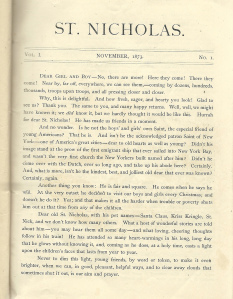
On my lapboard this stunning late winter day in the Colorado Rockies, is a very old book containing two 141-year-old magazines and four 140-year-old magazines. The crystallization into reality of Smith’s and Dodge’s dream: the very first volume of a life-changing magazine, St. Nicholas.
I’ve always been attracted to visionary dreams that change the world. I can only imagine what it would have been like in that New York editorial office when Smith handed Mrs. Dodge that very first magazine. In my introduction to “A St. Nicholas Magazine Christmas” (Christmas in My Heart® 17, 2008), I took our readers back in time to what it would have been like for a child or a teen to have been handed a copy of that magazine.
The fastest speed known to man was the train; transportation in general was still dominated by the horse. The telegraph office and the newspaper in each town were their windows to the world. The center of home life was the stove, kitchen, or fireplace–here is where family reading took place in the evenings. Paper was so rare that children, both at home and at school, tended to write with chalk on slate rather than using a pencil on paper. Childhood, as we know it today, didn’t exist back then, for children were expected to work as hard as adults. Education was all too brief; maybe, if you were lucky, three or four grades in a one-room schoolhouse. Girls especially faced an unenviable future for few careers other than marriage and motherhood were open to them. They were expected to marry by the ages of 14 to 17 (boys 15 to 18); children would then arrive on an average of every two years. No small thanks to the failure of doctors and midwives to wash their hands between patients, untold millions of women died of puerperal fever or childbirth “complications” – hence men tended to go through three wives in a lifetime. Life expectancy was short.
So just imagine yourself as an 1873 child or teen, as this magazine created just for you was delivered to your door. You’d be not only hungry for knowledge, you’d be voracious: all that knowledge out there, but inaccessible to you. Now here come, in your mailbox, windows to the world: history, biography, religion, literature, art, music, mythology, biology, architecture, anthropology, philosophy, technology, folklore, popular culture, and on and on. Authors and poets such as Jack London, Rudyard Kipling, Anthony Hope, Tennyson, Robert Louis Stevenson, Mark Twain, Louisa May Alcott, Longfellow, Bret Harte, Whittier, Frances Hodgson Burnett, William Cullen Bryant; and artists such as Arthur Rackham, Maxfield Parrish, Howard Pyle, Rembrandt, Rubens, Michelangelo, Leonardo, Frederic Remington, Charles Dana Gibson, Arthur Keller, etc.
Faithfully, for two-thirds of a century, three generations of young people received 1,200 pages of fascinating reading material every year. Without preaching or moralizing, the magazines helped inculcate principles of right living in its readers: character traits such as integrity, kindness, self-sacrifice, empathy, industry, courage, fortitude, self-respect, patriotism, respect for their elders, sportsmanship, etc.. – traits that bridged to the Golden Rule and service for others. Interwoven into the very fabric of the magazine was God’s leading in each of our lives. Thus, in its 66 years, St. Nicholas had a huge impact on the American people and British Commonwealth.
And yet, miraculously, defying all the odds, here is this refugee from another time, this 1873-74 artifact, on my lapboard! Thoughts and reactions almost overwhelm me. What will be the thoughts of people in 2155, 141 years from now, when they look back in time? Will there be any paper books left outside of mega library vaults? Will the average person be able to experience the thrill of touching and reading actual paper pages from times past? Or will the closest thing be digital? Digital recreations that lack any real connections to the real artifact itself. In that probable age of Orwellian Big Brother will they be forced to enter the Ray Bradbury world of Fahrenheit 451 and seek out those who memorized seminal books from the past (reason being totalitarian rulers have now erased all printed records that such books ever existed)? Even more terrifying, will there yet exist civilizations based on the Judeo-Christian belief system generations of children once grew up internalizing?
In a way, thousands of homeschooling parents are already circling their wagons around their children, earnestly seeking to preserve values worth living by for their children. Searching out real books, with the known potential to change lives for the better if their values are internalized. In a world that increasingly devalues real books, a revolution has already begun, a revolution every bit as significant as the one begun back in 1873-74 with this priceless book resting on my lapboard today.


March 5, 2014
IS UKRAINE OUR GENERATION’S MUNICH?
BLOG #10, SERIES #5
WEDNESDAYS WITH DR. JOE
IS UKRAINE OUR GENERATION’S MUNICH?
March 5, 2014
Preliminary indications and predictions add up to a bleak scenario for our time. Just to refresh your memory, go back through history to the events leading up to World War II: British Prime Minister Neville Chamberlain and his Conservative Party agreed to a foreign policy based on appeasement of Hitler. Chamberlain sought to draw Italy’s dictator Mussolii away from Hitler by concessions. In 1938, Chamberlain and his team met with Hitler and Mussolini in Munich and agreed to the rape of Czechoslovakia; and the stage was set for the horrific war that followed. Reason being: each back-down emboldened Hitler to gobble up another nation. History has not been kind to Chamberlain and his ill-conceived policy of appeasement.
Winston Churchill, Chamberlain’s successor, likened appeasers to a tiger that appeasers hope will eat them last.
So now we are faced with Janus-faced (one face to the Olympics, another to his opponents) Vladimir Putin, who is determined to crush the former countries that were freed by the fall of the Berlin Wall. U.S. and European leaders dithered like Chamberlain over Putin’s invading Georgia and Moldova (after the breakup of the Soviet Union), doing little to stop Putin. Now Obama is faced with Putin’s next step: the invasion of another sovereign nation, the Ukraine. Apparently, noting that Obama’s famous line in the sand for Syria’s dictator Assad turned out to be nothing but rhetoric, Putin feels empowered to do another land grab–not content with Russia’s already being the world’s largest nation.
Our current administration continues to weaken our armed forces in favor of entitlements, so our military is stretched paper-thin around the world. Already, Japan, seeing the backdown of Obama where Syria is concerned, realizes that it can no longer depend on America to defend it from the new tiger of the East, China, so it is beginning to rebuild its long inactive military. Now, Obama and Kerry are faced with their own moment of truth. The long fuse lit during the fiercely-fought primaries where Obama and Hillary Clinton fought almost to a draw. The issue of presidential guts was brought up then: that whoever won the presidency, after their honeymoon was over, inevitably their guts, or lack of them, would be severely tested by leaders of nations around the world. The question brought up then is clearly the question facing Obama now: Does he have the guts to stand toe to toe to Putin and demand that he pull back from the Ukraine? Guts such as Washington had, Lincoln had, FDR had, Truman had, Reagan had.
Let’s hope Obama will rise to the occasion and institute serious repercussions with real teeth for all our sakes– such as tough sanctions and freezing of Russian assets. If he does come through with real presidency toughness, it may end up defining his presidency.
Stay tuned. The Ukraine’s Crimea will answer this question.


February 26, 2014
Rafael Sabatini’s “Scaramouche”
BLOG #9, SERIES 5
WEDNESDAYS WITH DR. JOE
DR. JOE’S BOOK OF THE MONTH CLUB #27
RAFAEL SABATINI’S SCARAMOUCHE
February 26, 2014
As mentioned in our January 29 blog, our daughter Michelle suggested we pose one question to our Book Club members each month. By responding (on Facebook), we could thereby get more discussions in motion.
So here is Question #2: As you have journaled your book-related thoughts, what kind of mental dialogue with yourself has resulted? In other words, what do you find is most helpful in enabling you get to the essence of a given book?
Few historical novels are more beloved than this one. Certainly, it has long fascinated me. In fact, I have now read it around six times down through the years. And that’s unusual for I rarely read a given book more than once.
One reason for my returning to the book again and again has to do with my intense interest in the time period in which Sabatini sets the action: the French Revolution. That disruptive out-of-control time period that separates Louis XVI from the Napoleonic Empire. That French revolution breaking out a scant thirteen years after our American revolution.
Like most historical fiction readers, I’m not much interested in historical novels that are not true to their time period. I guess, in a way, I too like to have my general history reading sugar-coated by excitement and romance based on the author’s prior historical research of the time period.
Scaramouche has been filmed twice: first in 1923, and second (and more significantly) in 1952. Directed by George Sidney, and screenplay by Ronald Millar and George Froeschel. Star-studded cast includes Stewart Granger, Eleanor Parker, Janet Leigh, Mel Ferrer, Henry Wilcoxon, Lewis Stone, Nina Foch, Richard Anderson, and Robert Coote. The highlight is the climactic sword duel–longest in cinematic swashbuckling history.
The book begins with a famous line: “He was born with a gift of laughter and a sense that the world was mad.”
It takes a little while to get through the scene that triggers the rest of the almost unputdownable plot. But there’s far more to the book than mere action, intrigue, and romance: At the heart of it is this great truth: To know all is to forgive all.
It is not a book to read and forget: rather it is a book that keeps on giving as long as you live.
Rafael Sabatini’s life (1875-1950) was almost as eventful as his action-packed novels. He was born in the then small town of Jesi, Italy, near the seaport of Ancona. Apparently, he was illegitimate [not even a factor today in American when almost half of all children are born out of wedlock]. You will note in Scaramouche that the stain of his own birth gave Sabatini the incentive to dig deep into the issue in his fiction. Sabatini’s parents were well-known opera singers who traveled the world. His mother was English.
Sabatini grew up in England and Portugal, exposed to many languages. Early on, he fell in love with the borderland between England and Wales. In Porto, Portugal, Rafael attended a Catholic school. A few years later, the Sabatinis returned to Italy, this time to Milan. The son was then sent to a school in Switzerland. Here he added French and German to his linguistic arsenal. He spent most of his teenage years here.
When he was seventeen, his father sent him to Liverpool, England to immerse himself in the business world. But he soon turned to writing romances instead. By 1899, he was selling his short fiction to national magazines such as Pearson’s Magazine, London Magazine, and Royal Magazine. But once he devoted himself to full-time writing, he generally produced a book a year.
During World War I, he became a British citizen. In 1921, it was Scaramouche that catapulted him to world-wide fame; in fact, the book became an international best-seller. In 1922, Captain Blood sold even more copies.
His novels were set all over Europe, and in the New World as well. If you are anything like me, you will have developed such an addiction to his historical fiction by the time you finish Scaramouche, you will set about tracking down the rest of them for your library. Here they are:
The Tavern Knight, 1904
Bardelys the Magnificent, 1906
The Trampling of the Lilies, 1906
Love-at-Arms, 1907
The Shame of Motley, 1908
Saint Martin’s Summer, 1909
Anthony Wilding, 1910
The Lion’s Skin, 1911
The Life of Cesare Borgia, 1912 (history)
The Justice of the Duke, 1912
The Strolling Saint, 1913
Torquemada and the Spanish Inquisition, 1913 (history)
The Gates of Doom, 1914
The Sea-Hawk, 1915
The Banner of the Bull, 1915
The Snare, 1917
The Historical Nights’ Entertainment: First Series, 1918-1938
The Historical Nights’ Entertainment: Second Series, 1919
Scaramouche, 1921
Captain Blood, 1922
Fortune’s Fool, 1923
The Carolinian, 1925
Bellarion, 1926
The Nuptials of Corbal, 1927
The Hounds of God, 1928
The Romantic Prince, 1929
The Minion, 1930
The Chronicles of Captain Blood, 1931 (or Captain Blood Returns)
Scaramouche the Kingmaker, 1931
The Black Swan, 1933
The Stalking Horse, 1933
Captain Blood, 1936 (or The Fortunes of Captain Blood)
The Lost King, 1937
The Sword of Islam, 1938
Master-At-Arms, 1940
Columbus, 1942
If possible, secure a Houghton Mifflin hardback with dust-jacket. However, Bantam sold untold thousands in paperback form.


Joe L. Wheeler's Blog
- Joe L. Wheeler's profile
- 36 followers


